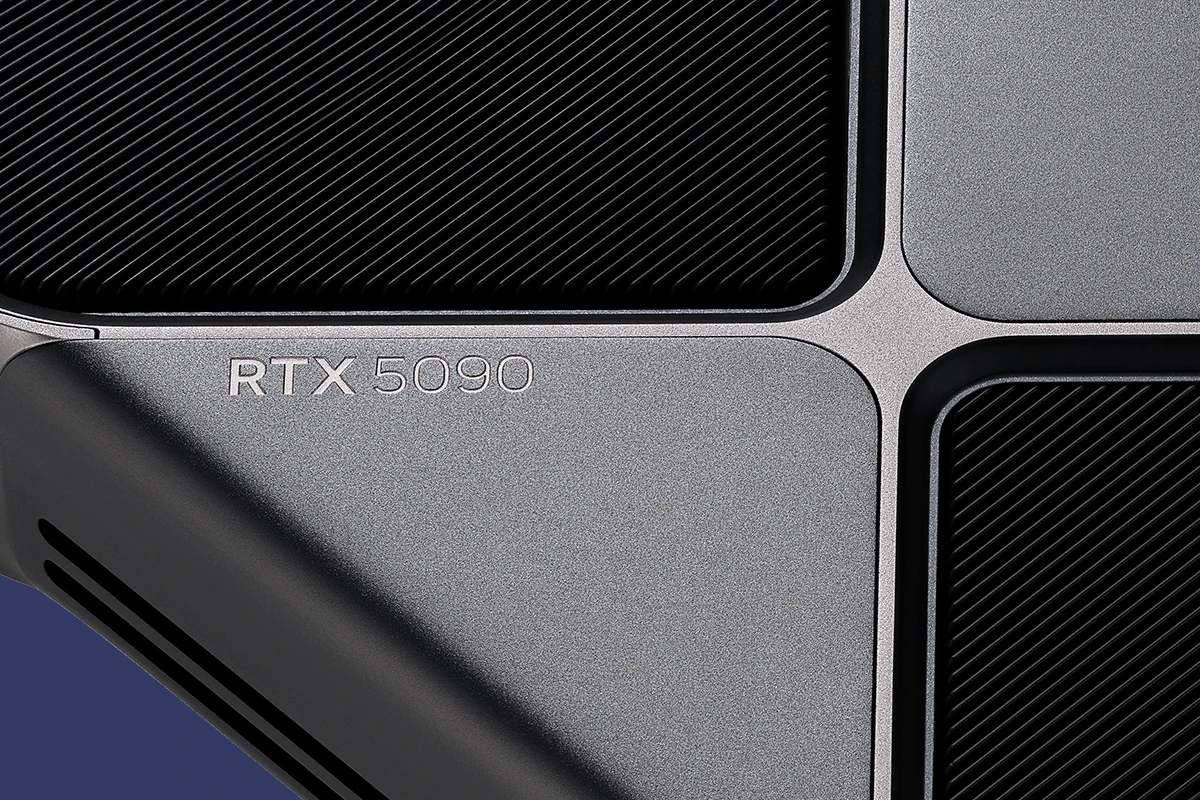NVIDIA has unveiled its latest lineup of graphics cards, marking a significant leap in gaming and AI technology. The new RTX 5000 series, based on the Blackwell architecture, includes four models: the RTX 5090, 5080, 5070 Ti, and 5070. These GPUs promise enhanced performance and efficiency over their predecessors.
The RTX 5090 stands out as the flagship model, boasting impressive specifications. It features 21,760 CUDA cores and a total board power of 575 watts. NVIDIA claims the entry-level RTX 5070, priced at $549, offers performance comparable to the previous generation’s top-tier RTX 4090. This suggests a significant improvement in price-to-performance ratio across the entire lineup.
The RTX 5090’s TBP is 575 watts, while the RTX 4090 has a TBP of 450 watts.
To find out how much higher the 5090’s TBP is, we can do the following calculation:
- Difference: 575 watts – 450 watts = 125 watts
- Percentage Increase: (125 watts / 450 watts) * 100% = 27.78%
So, the RTX 5090’s TBP is 125 watts higher than the RTX 4090’s TBP, which is a 27.78% increase.
Understanding the RTX 5090’s Power Demands
The NVIDIA RTX 5090 is expected to feature a power consumption of 575 watts, marking a more than 25% increase compared to the previous generation’s top-tier card, the RTX 4090, which had a TBP of 450 watts. This shift highlights a broader trend in high-performance computing, demanding enhanced hardware design and power delivery.
Users planning to use the RTX 5090 must assess their power supply, cooling solutions, and system configuration to support the new card’s higher requirements.
What 575 Watts Means
The buzz around the NVIDIA RTX 5090 centers on its rumored 575-watt Total Board Power (TBP). This number tells us how much power the entire graphics card consumes. A higher TBP often means better performance, but it also has implications for your PC setup. The RTX 4090, for comparison, has a TBP of 450 watts. This 125-watt jump suggests a big performance increase for the 5090 but also means you’ll need a more powerful power supply and better cooling.
Why So Much Power?
Several factors contribute to this increased power draw:
- New Architecture: The RTX 5090 will likely use NVIDIA’s next-generation Blackwell architecture. New architectures often bring performance gains but can also require more power.
- More Cores and Higher Clocks: More processing cores and faster clock speeds mean more calculations per second, but they also use more power.
- Faster Memory: The 5090 is expected to use GDDR7 memory, which is faster than the GDDR6X used in the 4090. This faster memory contributes to the higher power consumption.
What This Means for You
If you’re thinking about getting an RTX 5090, here’s what you need to consider:
- Power Supply: You will likely need a high-quality power supply with at least 1000 watts of capacity, possibly more, to handle the 5090 and the rest of your system.
- Cooling: A 575-watt card will generate a lot of heat. You’ll need a robust cooling solution, such as a high-end air cooler or a liquid cooling setup.
- Case Size: Make sure your PC case has enough space for the large card and its cooling solution.
Comparing Power Requirements
Here’s a table comparing the power consumption of some recent high-end NVIDIA GPUs:
| GPU | Total Board Power (TBP) |
|---|---|
| RTX 3090 | 350W |
| RTX 3090 Ti | 450W |
| RTX 4090 | 450W |
| RTX 5090 | 575W |
Addressing Common Concerns
Some people worry about the increasing power demands of GPUs. While it’s true that more power means more heat and higher electricity bills, it also allows for significant performance improvements. These improvements can lead to better gaming experiences, faster content creation workflows, and advancements in AI and other fields.
Alternatives and Considerations
If the RTX 5090’s power consumption is a major concern, you might consider other options. You could wait for more information about the card’s efficiency or consider a lower-tier card from the same series, which would likely have lower power requirements. You could also wait and see what AMD offers as competition. They are rumored to be releasing high-end GPUs as well. It’s best to wait for official reviews and benchmarks to be released before making a final decision.
Power Efficiency and Performance
While raw power consumption is important, it’s also crucial to consider performance per watt. A more efficient card can deliver similar or even better performance than a less efficient card with a higher TBP. This is an area to watch closely when official reviews of the RTX 5090 are released. You’ll want to compare the performance gains relative to the increase in power consumption.
Understanding Power Supply Requirements for High-End GPUs
Given the RTX 5090’s expected power draw, choosing the right power supply unit (PSU) is critical. A PSU that’s not powerful enough can lead to system instability, crashes, or even damage to your components. When selecting a PSU for a high-end graphics card like the RTX 5090, it’s essential to consider more than just the wattage. Look for a PSU from a reputable brand with high efficiency ratings (like 80+ Gold or Platinum) and sufficient connectors for your components. It’s often recommended to have some headroom in your PSU’s wattage, so a 1000W or even a 1200W PSU might be a good choice for the RTX 5090, depending on your other components. Don’t cheap out on the PSU as it is the backbone of your system. A cheap PSU can cause damage to other components if it fails.
Key Takeaways
- NVIDIA introduces four new RTX 5000 series GPUs based on Blackwell architecture
- The RTX 5090 leads the pack with 21,760 CUDA cores and 575 watts power consumption
- NVIDIA claims the $549 RTX 5070 matches the performance of the previous RTX 4090
NVIDIA Unveils Four New Blackwell GPUs, Claims RTX 5070 Matches RTX 4090
New Graphics Cards Announced
NVIDIA has released details on its latest GPU lineup. The company introduced four new graphics cards:
- RTX 5090: $2,000
- RTX 5080: $1,000
- RTX 5070 Ti: $750
- RTX 5070: $550
The RTX 5090 and 5080 will be available on January 30. The 5070 Ti and 5070 will launch in February.
Blackwell Architecture
The new GPUs use NVIDIA’s Blackwell architecture. This design has 92 billion transistors, up from 76 billion in the previous generation.
The RTX 5090 card shown by NVIDIA’s CEO is smaller than past models. It has two fans and takes up two slots. This is a change from the larger three and four-slot cards of recent years.
Technical Specifications
The RTX 5090 has these key specs:
- 21,760 CUDA cores
- 32 GB GDDR7 memory
- 2.41 GHz boost clock
- 512-bit memory interface
- 575W power draw
For comparison, the RTX 4090 had:
- 16,384 CUDA cores
- 24 GB GDDR6X memory
- 2.52 GHz boost clock
The other new cards have these specs:
| Model | CUDA Cores | Memory | Boost Clock | Power Draw |
|---|---|---|---|---|
| RTX 5080 | 10,752 | 16 GB | 2.62 GHz | 360W |
| RTX 5070 Ti | 8,960 | 16 GB | 2.45 GHz | 300W |
| RTX 5070 | 6,144 | 12 GB | 2.51 GHz | 250W |
Performance Claims
NVIDIA says the RTX 5070 matches the RTX 4090 in performance. The company also states this is only possible due to AI and GDDR7 memory.
NVIDIA’s charts show the 5090 outperforming the 4090 by over 2x in some games. However, these tests use different settings for each card. The 5000 series uses a new “MFG 4x mode” while the 4000 series uses standard frame generation.
Similar claims are made for the other new cards:
- RTX 5080: Up to 2x faster than RTX 4080
- RTX 5070 Ti: Over 2x faster than RTX 4070 Ti
- RTX 5070: Over 2x faster than RTX 4070
These comparisons also use different settings, making direct performance comparison difficult.
AI Features
NVIDIA highlighted AI capabilities in the new GPUs. A key feature is DLSS 4 with Multi-Frame Generation (MFG).
DLSS 4 can generate up to three extra frames for each rendered frame. NVIDIA claims this can boost frame rates by up to 8x compared to standard rendering.
The new AI model for frame generation is:
- 40% faster
- Uses 30% less VRAM
- Only needs to run once per rendered frame
These improvements allow the generation of multiple frames from a single rendered frame.







